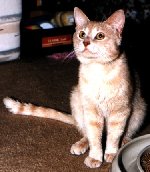|
Rusty  was a stray orange tabby who found me in
mid-April 1998. He was estimated to be about 1-1/2 years old and was neutered and
vaccinated immediately after his arrival. Other than a slight heart murmur and being
malnourished, he seemed to not have any other problems. He was drinking and eating
excessively, but I attributed this to his malnutrition. He also was urinating outside of
his litterbox, but it took me a week to find out it was him (I have four other cats). As
soon as I realized he was the one having the accidents, which was two weeks after his
arrival, I took him to the vet and requested a urinalysis, expecting a severe bladder
infection. Instead, he was diagnosed with diabetes. The excessive eating, drinking, and
urinating outside the box are classic symptoms of diabetes. Unfortunately, we do not know
his history, but diabetes in a cat as young as him is uncommon. was a stray orange tabby who found me in
mid-April 1998. He was estimated to be about 1-1/2 years old and was neutered and
vaccinated immediately after his arrival. Other than a slight heart murmur and being
malnourished, he seemed to not have any other problems. He was drinking and eating
excessively, but I attributed this to his malnutrition. He also was urinating outside of
his litterbox, but it took me a week to find out it was him (I have four other cats). As
soon as I realized he was the one having the accidents, which was two weeks after his
arrival, I took him to the vet and requested a urinalysis, expecting a severe bladder
infection. Instead, he was diagnosed with diabetes. The excessive eating, drinking, and
urinating outside the box are classic symptoms of diabetes. Unfortunately, we do not know
his history, but diabetes in a cat as young as him is uncommon.
My vet started Rusty on NPH insulin twice a day, but it's duration was poor. The second
insulin was Humulin Ultralente. My vet was not pleased with BGs on this either, so we
switched to locally compounded PZI. By the end of June, he was going through an entire
bottle of PZI every 5 days, still having accidents, had excessive PU/PD (urinating and
drinking), felt miserable, and not a single BG under 500 since diagnosis. The vet and I
met and discussed a lot of things at this point. I brought up a lot of ideas I got from
the diabetes lists and along with ideas of his, we came up with a complete new plan. Up to
this point, we had been free-feeding Hill's W/D. He did not seem to get
"satisfied" so I started feeding him 1/4 cup W/D with 1/2 jar of Gerber turkey
or chicken baby food (never give a cat anything with onion or onion powder as it is toxic
to them) twice a day along with his shots and free-feed dry available at all times. I am
gone during the day at work, so I prefer to leave free-feed out for him in case his bg
gets too low when I am not home. Along with this food, he started a powder enzyme
supplement (to eliminate soft stools), a vitamin and a small amount of chromium. Within a
few days, the stools improved and he stopped camping out at the water bowl and free-feed
bowl. He also had an infected place on his tail that would not heal for which the
vet prescribed antirobe. All of these things happened at once and improvements were seen
in Rusty's behavior almost immediately.
I also started home bg testing with a glucometer elite. There were several reasons for
this: vet bills were getting costly, Rusty was becoming very stressed at spending so much
time at the vets, and I was very fearful of a hypoglycemic episode because of the large
doses he was getting. For the next two months, I would do a 12 hour curve on the weekend
and write the numbers down along with any observations - bad or good - and would drop them
off at my vet. He would advise me on how much to increase dosages and by the end of July,
he was getting 18U, twice a day. Then, we started going back down on insulin because his
bg was getting too low. Rusty has had lows as low as 19 without symptoms (thank goodness
for the glucometer!).
We have never experienced Somogyi or ketoacidosis, although I check for that by doing home
BG curves and occasional home urine glucose and ketone tests. Although his BG numbers
could use improvement, we have not seen anything over 400 since July and rarely over 350.
I test his BG at shot time (which is his peak time or lowest BG). If he is low, I either
give a reduced dose or skip the shot, according to what my vet has instructed for a
particular range of numbers. We are continuing with the current regimen since it has been
so successful, but are discussing possibilities of what can be done to
"fine-tune" the BGs. It is unfortunate not to know his history, but since he is
so young, transient diabetes is still a possibility which makes me hesitant to change
anything.
Now, in December, he is receiving between 4U - 6U twice a day, has gained weight, feels
great all the time and his heart murmur appears to have gone away. He is a very healthy
and happy cat, which proves that diabetes is a treatable disease in animals. Rusty's
success can be attributed to a wonderful vet who is educated, yet open to new ideas,
support from diabetes lists and education about the disease. Things that I thought were
impossible 6 months ago are routine now. Please give your pet a chance for life - because
diabetes is treatable!
Contributed by Barb.
  



Contributed December 1998
7 Years as a Diabetic - 2005
Copyright. All rights reserved.
This site is for information purposes only. Please consult
your veterinarian. |
 Rusty's Story
Rusty's Story Rusty's Story
Rusty's Story